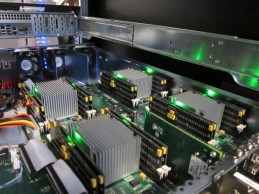Phase change memory-based ‘moneta’ system points to the future of computer storage
June 3, 2011

A view of the internals of the Moneta storage array with phase change memory modules installed (credit: UC San Diego/Steve Swanson)
A team of engineers at the University of California, San Diego is about to demonstrate a phase-change memory solid state storage device that provides performance thousands of times faster than a conventional hard drive and up to seven times faster than current state-of-the-art solid-state drives (SSDs).
The storage system, called “Moneta,” uses phase-change memory (PCM), an emerging data storage technology that stores data in the crystal structure of a metal alloy called a chalcogenide. PCM is faster and simpler to use than flash memory, the engineers said.
To store data, the PCM memory chips switch the alloy between a crystalline and amorphous state based on the application of heat through an electrical current. To read the data, the chips use a smaller current to determine which state the chalcogenide is in.
Moneta uses Micron Technology’s first-generation PCM chips. It can read large sections of data at a maximum rate of 1.1 gigabytes per second, and write data at up to 371 megabytes per second. For smaller accesses, Moneta can read at 327 megabytes per second and write at 91 megabytes per second, which is two to seven times faster than a state-of-the-art, flash-based SSD.
Moneta also provides lower latency for each operation and should reduce energy requirements for data-intensive applications, the engineers said.
The device will be on exhibit June 7-8 at DAC 2011.